RESEARCH
Thomas
J. Algeo
Professor
of Geology
University
of Cincinnati
Development
of Paleomarine Environmental Proxies
|
The environmental
conditions in paleomarine systems can be interpreted from many types of
proxies, but the use of trace-element data has been underdeveloped to
date. Commonly, the concentrations of trace metals such as
molybdenum (Mo) are used to infer paleoredox conditions, with higher
concentrations indicative of more reducing environments. This
relationship is valid in a general sense, as shown by studies of modern
(above; Zheng et al., 2000) and ancient marine systems (below; Algeo and
Maynard, 2004). However, trace-metal concentrations in marine
sediments are also strongly influenced by hydrographic factors, as shown
by Algeo (2004), Algeo and Lyons (2006), and Algeo and Maynard (2008).
|
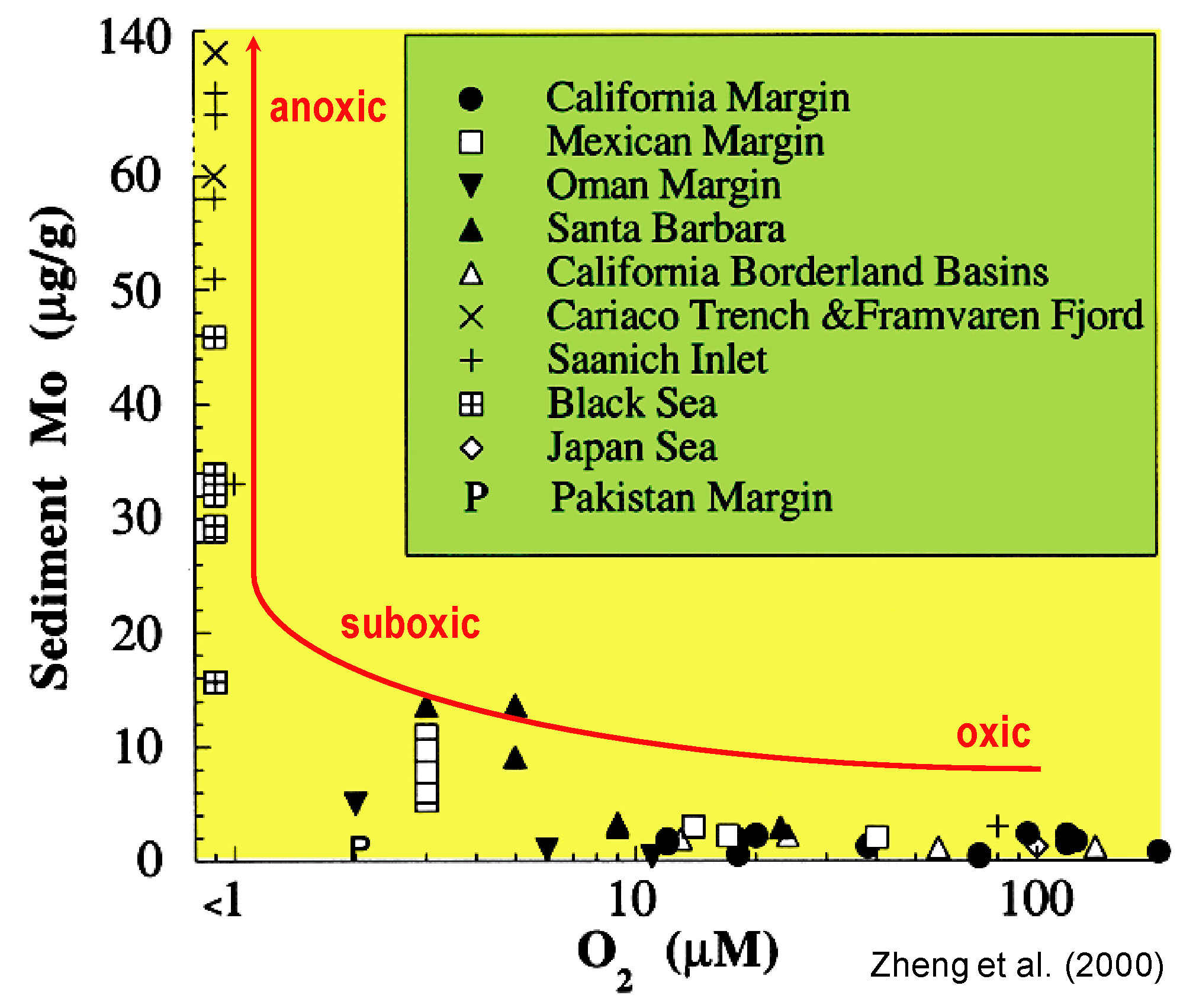
|
|

|
| The concentrations of trace
metals in seawater are nearly uniform globally for those metals having
long residence times in seawater, e.g., Mo (~700 kyr) and U (~400 kyr).
However, the aqueous concentrations of these trace metals may deviate
strongly from that of seawater in restricted marine systems with reducing
deepwaters, in which trace metals are removed at relatively high
rates. As a consequence of such rapid removal, the concentrations of
trace metals in the deep watermass will be drawn down to varying degrees,
as in the modern Cariaco Basin (right; Algeo and Maynard, 2008). The
degree of drawdown of any given metal, such as Mo, varies among restricted
basins, with strongly restricted basins such as the Black Sea and
Framvaren Fjord showing greater drawdown than weakly restricted basins
such as the Cariaco Basin and Saanich Inlet (far right; Algeo and Lyons,
2006; Algeo and Rowe, 2012). |

|

|
| Trace-metal concentrations in
marine sediments vary as a function of degree of deepwater drawdown, as
discussed above. This pattern is most readily observed by
cross-plotting a trace metal such as Mo versus total organic carbon, or
TOC. Strong restriction results in lower Mo content per unit TOC
than weak restriction in both modern (right; Algeo and Lyons, 2006; Algeo
and Rowe, 2012) and ancient marine systems (far right; Algeo et al.,
2007). Because organic matter is the main host phase for trace
metals in the sediment, total uptake "capacity" of the sediment
correlates with TOC content. |
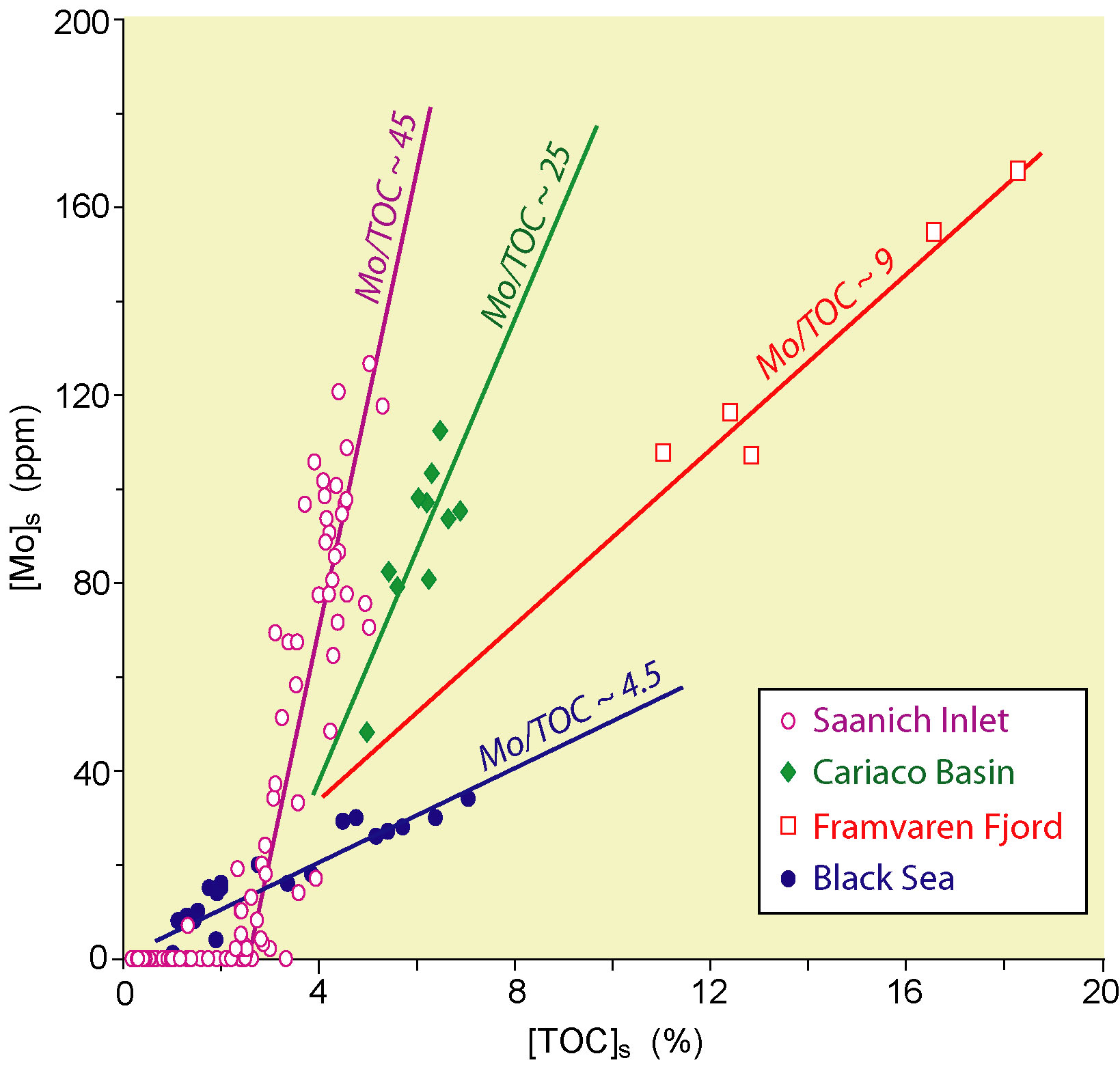
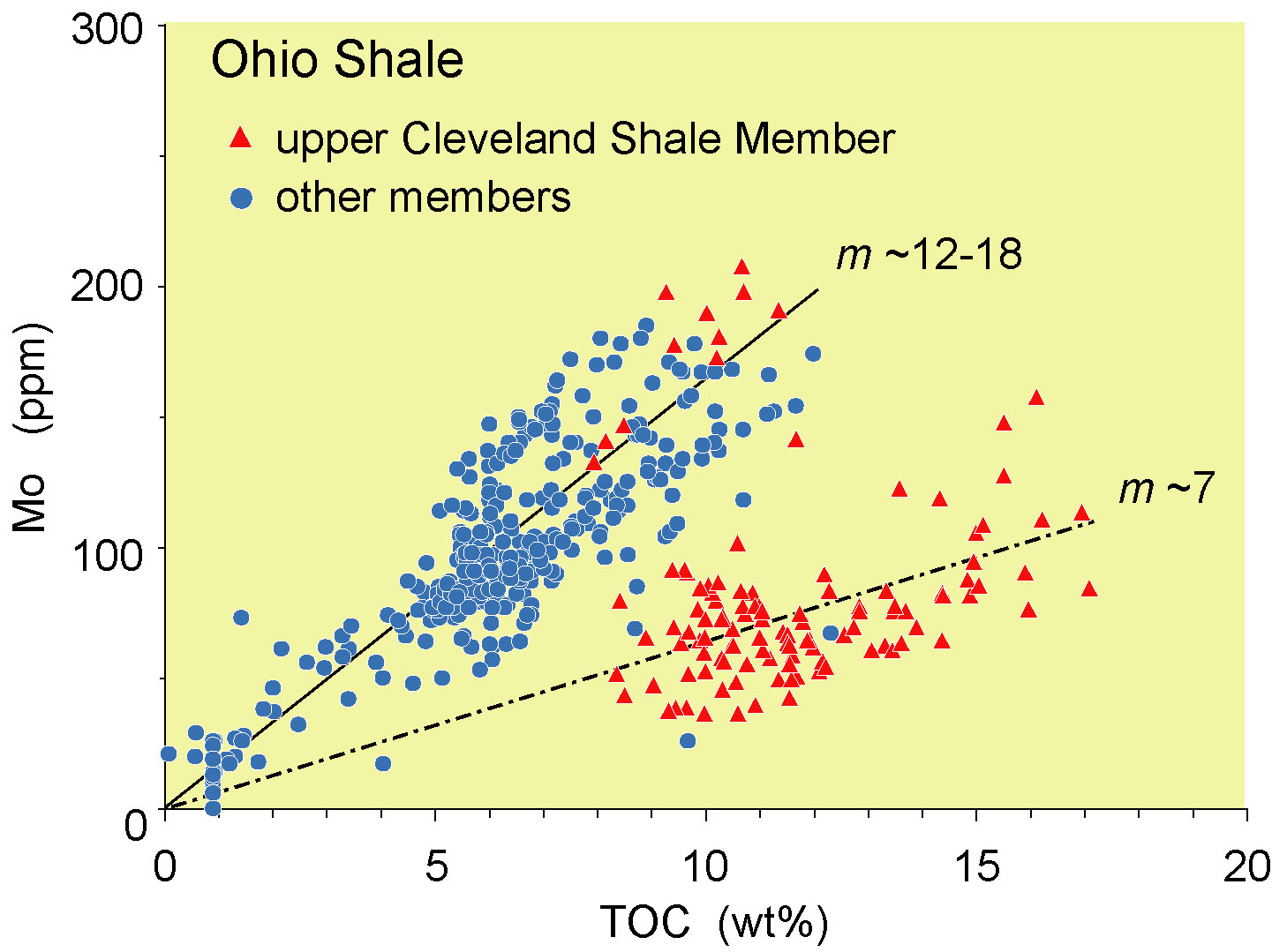
|
| The relationships between Mo,
TOC, and watermass restriction in modern marine systems (above) are
potentially useful for interpretation of watermass conditions in
paleomarine systems. A high Mo/TOC ratio (given as 'm', in units of
10^-4) is indicative of weak watermass restriction, whereas a low Mo/TOC
ratio is indicative of strong watermass restriction. The Mo/TOC
ratio of ancient marine sediments can be used to estimate paleo-deepwater
trace-metal concentrations (right) and renewal times (far right). |
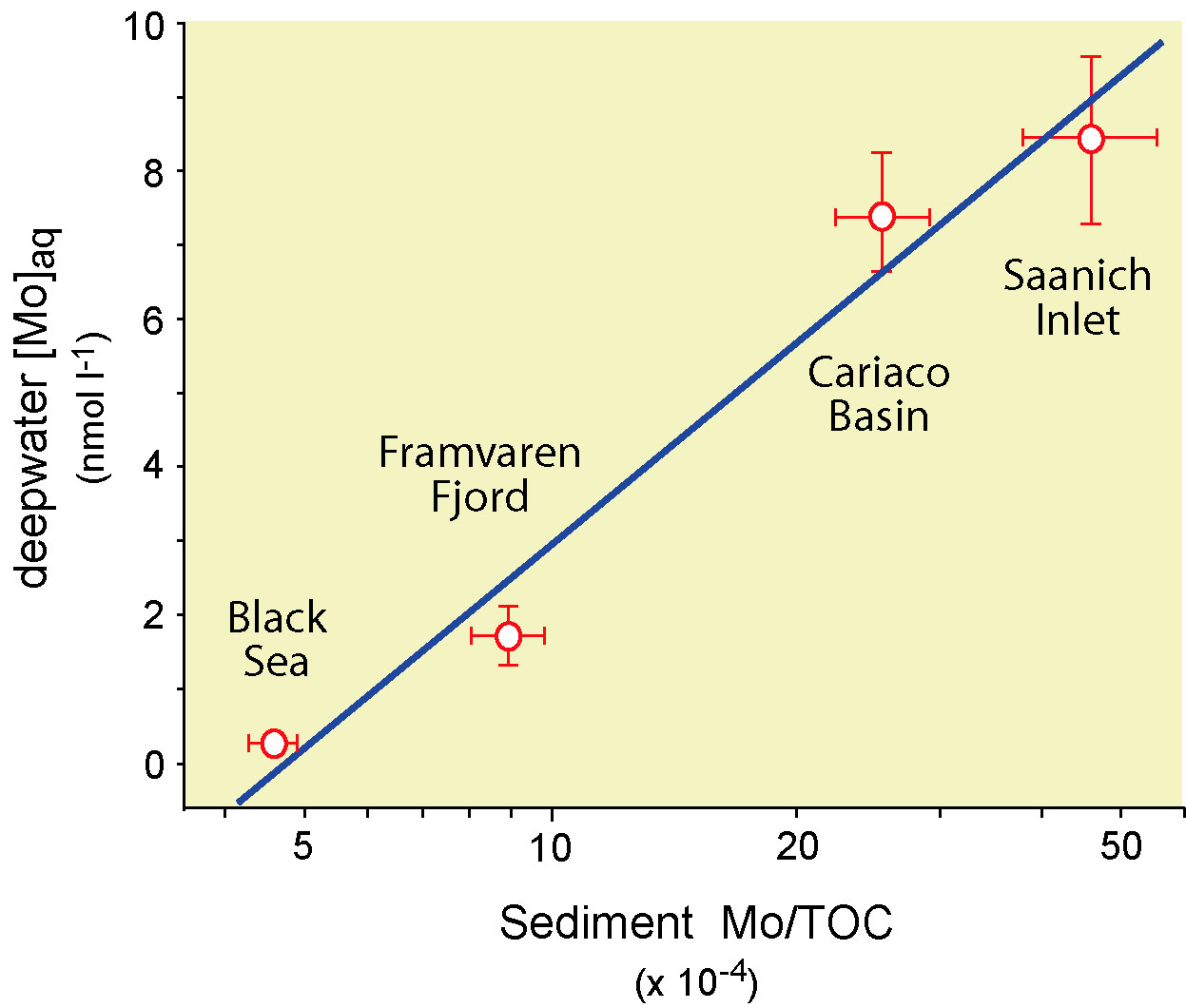 |
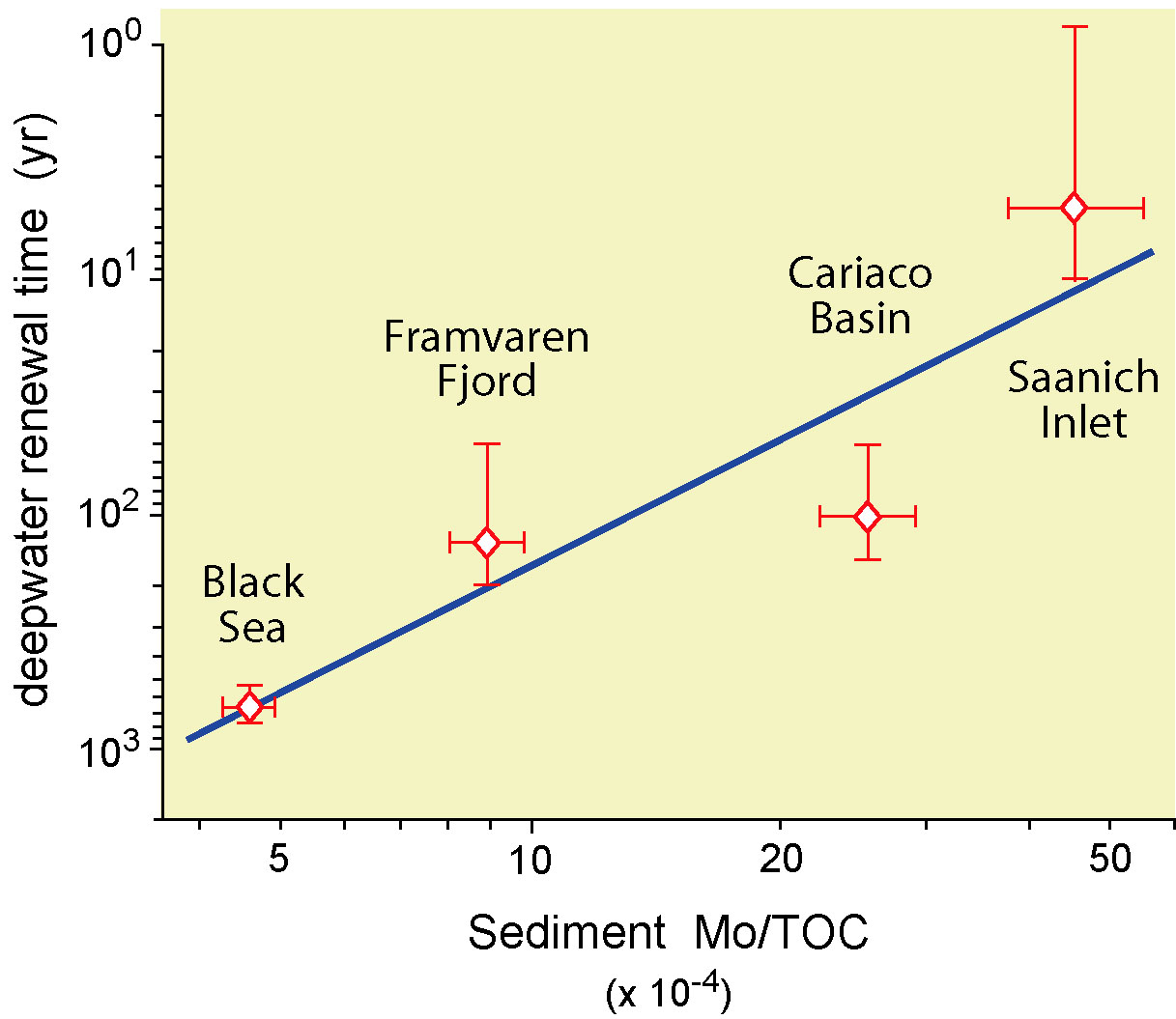 |
|
The principles above can be used to reconstruct
hydrographic conditions in paleomarine systems, such as the Devonian
epeiric seas of North America (right; Algeo et al., 2007). Other
examples of this application include:
-
Coniacian-Santonian
(März et al., 2009)
-
Cenomanian-Turonian
(Hetzel et al., 2009)
-
Toarcian (McArthur
et al., 2008)
-
Permian-Triassic (Xu
et al., 2009)
-
Mississippian (Rowe
et al., 2008)
|
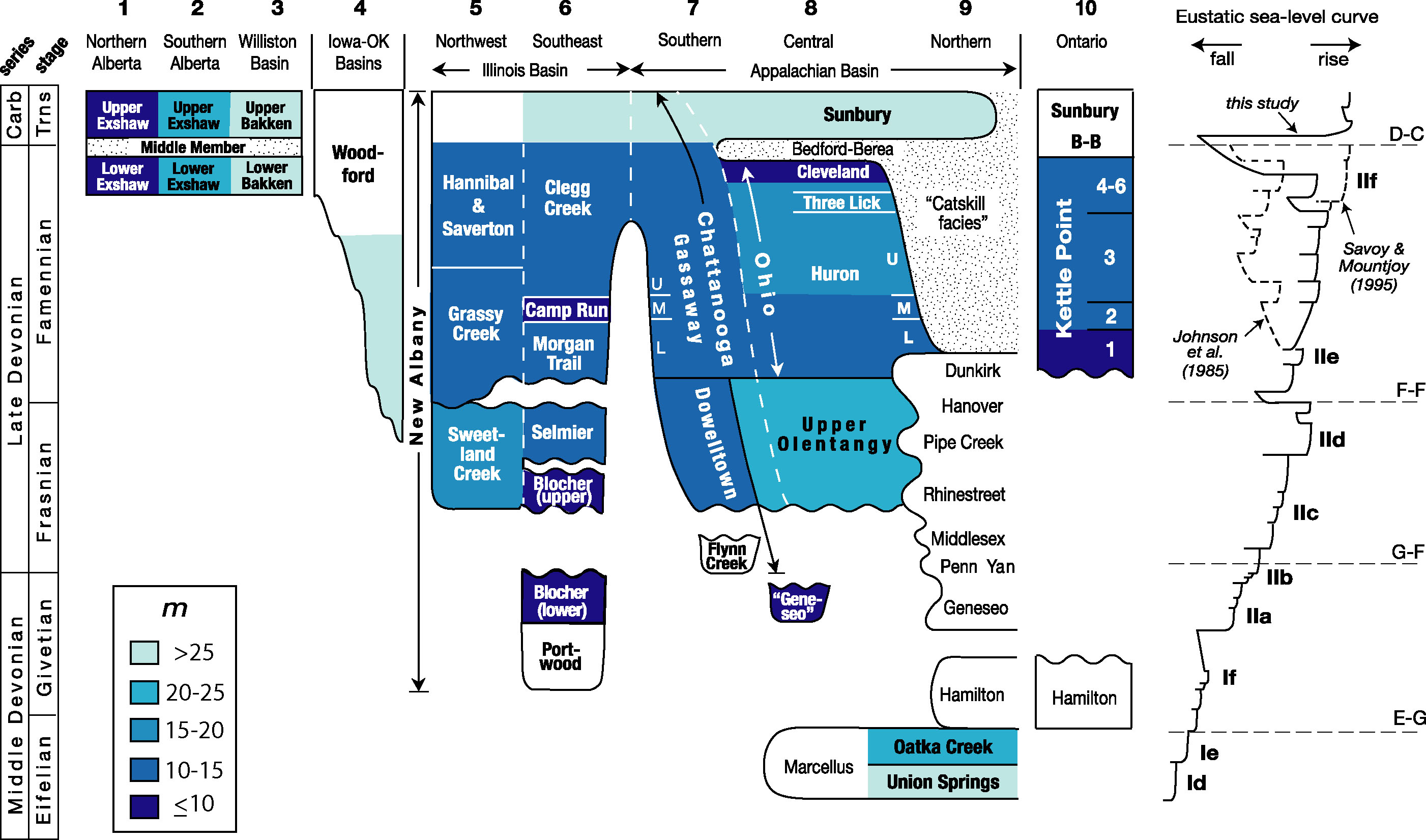
|
References
Algeo, T.J., 2004. Can
marine anoxic events draw down the trace-element inventory of seawater? Geology
32, 1057-1060.
Algeo, T.J.,
Lyons
, T.W., 2006. Mo–total organic carbon covariation in modern anoxic marine
environments: Implications for analysis of paleoredox and paleohydrographic
conditions. Paleoceanography 21, PA1016, 23 pp.
Algeo,
T.J., Maynard, J.B., 2004. Trace element behavior and redox facies in core
shales of Upper Pennsylvanian Kansas-type cyclothems. Chem. Geol. 206, 289-318.
Algeo,
T.J., Maynard, J.B., 2008. Trace metal covariation as a guide to water-mass
conditions in ancient anoxic marine environments. Geosphere 4(5), 872-887.
Algeo,
T.J., Rowe, H., 2012. Paleoceanographic applications of trace-metal
concentration data. Chemical Geology,
v. 324-325, p. 6-18. doi:10.1016/j.chemgeo.2011.09.002.
Algeo,
T.J.,
Lyons
, T.W., Blakey, R.C., Over, D.J., 2007. Hydrographic conditions of the Devono-Carboniferous
N
orth American Seaway inferred from sedimentary Mo-TOC relationships. Palaeogeogr.
Palaeoclimatol. Palaeoecol. 256, 204-230.
Hetzel,
A., Böttcher, M.E., Wortmann, U.G., Brumsack, H.-J., 2009. Paleo-redox
conditions during OAE 2 reflected in Demerara Rise sediment geochemistry (ODP
Leg 207). Palaeogeogr. Palaeoclimatol. Palaeoecol. 273, 302-328.
März,
C., Beckmann, B., Franke, C., Vogt, C., Wagner, T., Kasten, S., 2009. Geochemical
environment of the Coniacian-Santonian western tropical
Atlantic
at Demerara Rise. Palaeogeogr. Palaeoclimatol. Palaeoecol. 273, 286-301.
McArthur,
J.M., Algeo, T.J.,
van de Schootbrugge
, B., Li, Q., Howarth, R.J., 2008. Basinal restriction, black shales, and the
Early Toarcian (Jurassic) oceanic anoxic event. Paleoceanography 23, PA4217,
doi:10.1029/2008PA001607.
Rowe,
H.D., Loucks, R.G.,
Ruppel
,
S.C.
, Rimmer, S.M., 2008. Mississippian Barnett Formation,
Fort Worth Basin
,
Texas
: Bulk geochemical inferences and Mo–TOC constraints on the severity of
hydrographic restriction. Chem.
Geol. 257, 16-25.
Xu, G., Hannah, J.L., Stein, H.J., Bingen, B., Yang, G., Zimmerman, A.,
Weitschat, W., Mørk, A., Weiss, H.M., 2009. Re-Os geochronology of Arctic black shales to
evaluate the Anisian-Ladinian boundary and global faunal correlations. Earth
Planet. Sci. Lett. 288, 581-587.
Last
updated 17 Sept 2012
Back
to Research Page
Back
to Homepage